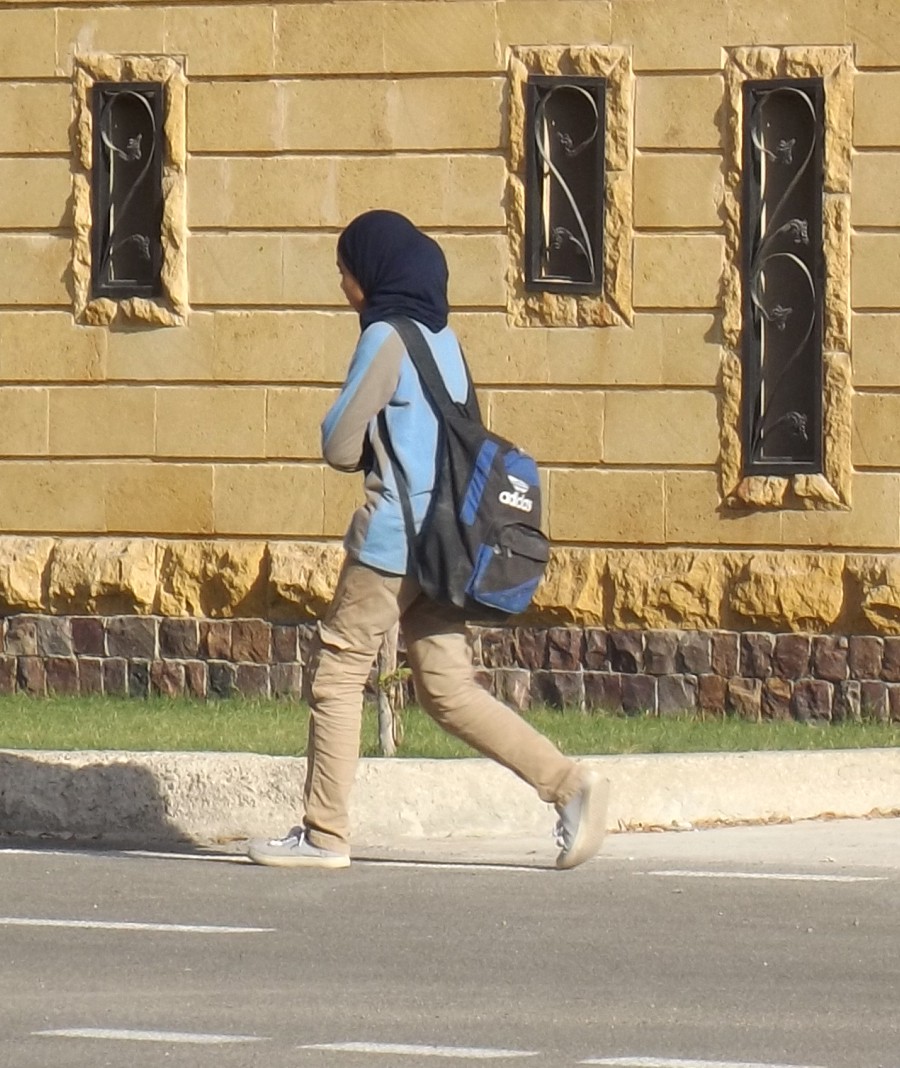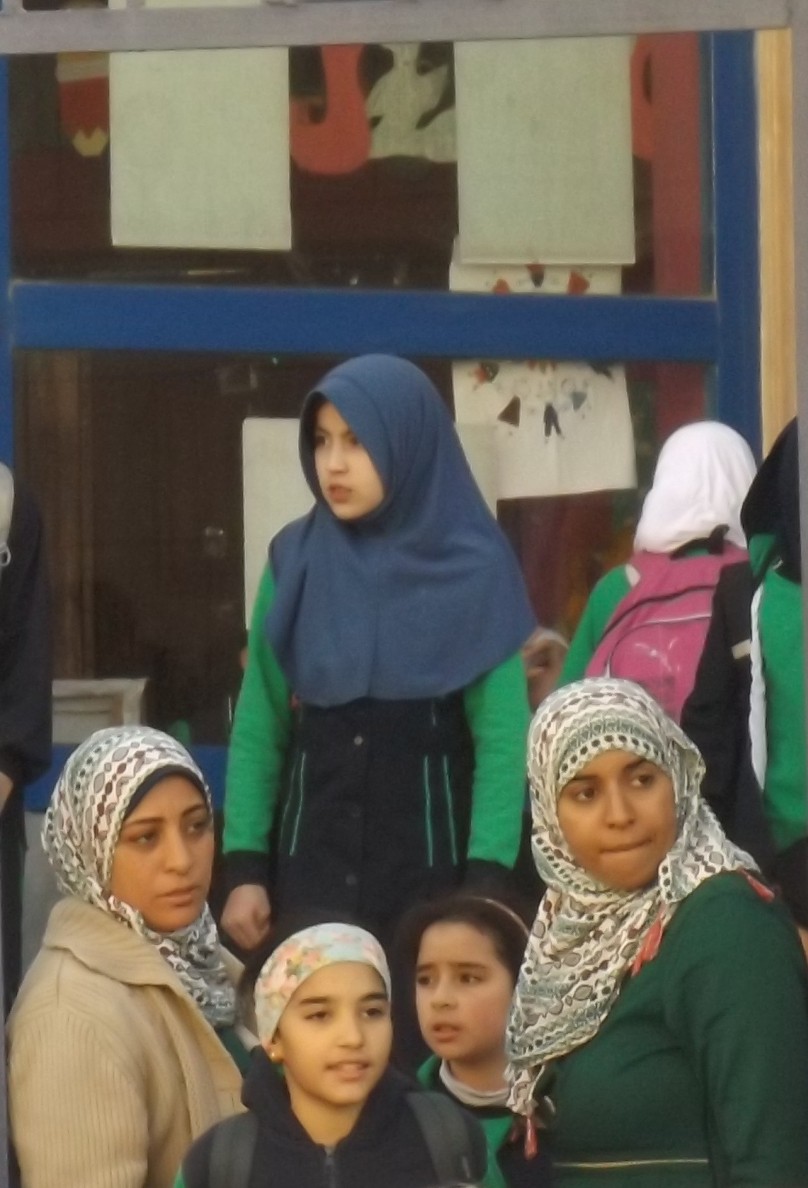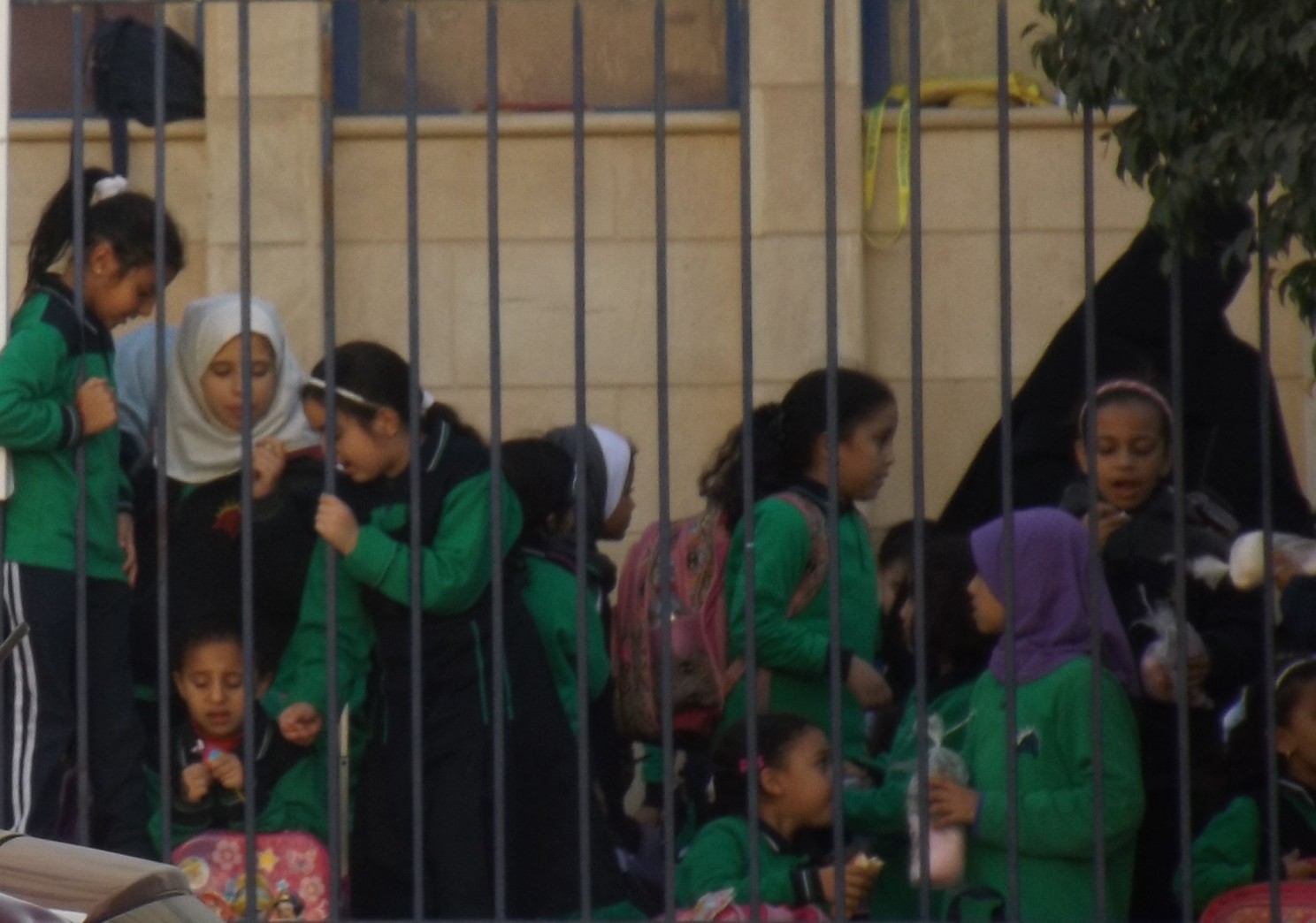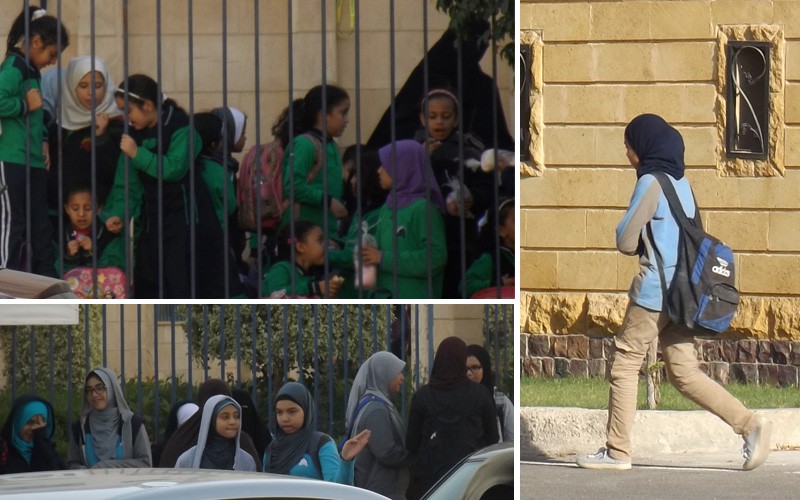“He’s listening.” That’s what they told us about God, so we can doubtlessly raise our hands and pray; so we can have these silent conversations with Him about what we’ve down wrong, about what’s fair; to create this relationship, this unbreakable bond. Yet somehow, this God-believer relationship was interrupted by human interventions. Now, the question remains to be, are Islamic schools raising our girls to become the educated, religiously-wealthy individuals we want them to be? Or are they making veils, manners and everything else all about following school rules and not God’s orders?

What do primary kids know about veils?
Is it just about playing dress-up like mamma? Or is there more to it than that? In support of the fact that they are too young to process the concept of veils, and that it’s not even a religious requirement pre-puberty, the Minister of Education Moheb El-Rafie banned forcing veils on primary girls in 2015. Yet somehow, that doesn’t guarantee you won’t be seeing girls the size of your small finger running around with veils. “She wears it sometimes, and takes it off at other times. She likes to try it out,” explains the father of a fourth primary-veiled girl who goes to an Azhar-school. Rozayna Hesham, another primary kid, also stated that she permanently wears the veil, and clarified that she loves it.
When asking psychiatrist Hossam El-Din Salah about this phenomenon, he explained by saying, “In psychology, this is what we call learning by observation. The child mimics his/her parent or role model, and this explains why a girl can try to wear makeup or put on a veil just to imitate her mother. At a more advanced age, the girl starts realizing that she is part of a community that supports the same idea, so she accepts this idea in attempt to fit in and gain the associations that come with it. For example, being veiled is associated with being respectable, or honorable.”
With this bared in mind, is taking it off as easy as putting it on? Should the veil-decision be coming from your heart or the headmistress’s mouth?
Putting on a veil doesn’t just mean covering your hair, it changes everything. It puts restrictions on the way you dress, the way you behave, and with respect to it, you become worthy of it. It requires some inner readiness to make such a commitment; a readiness that varies with our individual differences. In contrast to that, a fair share of Islamic schools force veils on girls as part of the school uniform at certain educational stages. “In our community, we like our girls to get veiled as soon as they hit puberty” says Walaa Sayed; a parent, in response to her girl’s school veiling policy that forces veil-wear by first preparatory. Salwa Gamal, another mother to a girl that goes to the same school, had a supporting opinion when asked what she’d do if her daughter wasn’t ready or convinced yet by that time. “I will convince her,” she persists.
“I used to wear it at school and take it off outside,” says Mariam Hassan; a Grade 11 student at an Azhar School. Conflicting as this is, it necessitates the question; is the girl then wearing it for God or for school?
But even when Islamic schools don’t force veils directly, they sometimes resort to indirect techniques. “Religion and Qur’an teachers won’t stop talking about it, which is fine, but even their compelling technique is wrong. Instead of highlighting God’s reward to those who wear Hijab, they settle for focusing on the punishment we’d receive if we don’t,” explains Rawan Hamdy; an unveiled student. “Even though my school supposedly doesn’t force Hijab on us, my friend once took off her veil in class when there weren’t any boys around and was still suspended for days,” she adds. Rawan was suspended herself in preparatory stage for days because she had hair bangs. “They told me I should wear my hair like that to the club instead,” she says.
Nada Nader; a former Islamic school student who didn’t deal with either previously mentioned complications complained more about peer pressure and cultural norms. “When I was in Grade 10, almost 99% of the girls in my class were veiled, and only two other than me weren’t. It wasn’t exactly nice when people jumped to conclusions and assumed I was a bad person just because I wasn’t veiled,” she clarifies.
Apparently, Islamic schools’ control could stretch far enough to not only veil girl-students but also their parents. Olga Hassan; a Russian Muslim who had decided to send her kid to an Islamic school, seeking out an Islamic identity, also sent her to an Islamic sports academy associated with the school for a swimming training. This decently dressed woman who isn’t veiled wasn’t allowed to attend her own daughter’s training. “They asked me to cover up my hair so I can get in,” she said.
Can pressure be in the form of uniforms, sports-deprivation, and gender-division?
“At my school, there is a perforated fence that separates us from the boys. The school put a prayer mat to cover it up so we wouldn’t see each other,” says Nour Hossam; a Grade 11 student, explaining that, even after she transferred to the mix IG section of her school, talking and interacting with boys was totally banned. Sometimes passing by the boys’ hallway by chance was considered a law-breaking act. “If you ask me, I think this usually leads to boys becoming clueless about dealing with girls, and causes some psychological instabilities,” adds Nour.
Shifting angles, from a parental perspective, this gender division perfectly makes sense. “I used to send my daughter to a non-Islamic school but I had her transferred, because boys are aggressive by nature, and girls are just quieter. I didn’t want anyone hitting her or having any physical contact with her,” Salwa Gamal explains. Rawan Hamdy, on the other hand; a student who goes to the same school as her nephew, says she tried playing with him at school only to get a ‘Girls play with girls, and boys play with boys’ response from him. On the contrary is former Islamic school student, Yasmine Ali, who found this division reasonable. “I think the stories I used to hear from my friends about boys satisfied my curiosity and I was able to maintain balance,” she explains.
But it doesn’t just take having boys one prayer mat away to be pressured, because a piece of clothing that you put on everyday can certainly affect your self perception. Nada Nader, a girl who used to be overweight in primary school, was discriminated because of her weight when she was the only one of her friends to wear a long skirt. “They used to make jupe-shorts for primary girls because it’s difficult for them to wear long skirts, but because I was oversized, I was the only one of my friends who was forced into this long skirt. And for a kid, that was unfair,” she protests. In support of this argument is Zeina Amr; a senior student who complained about the banning of the school P.E. pants, because apparently, they were later identified a ‘taboo’.

Bursting from the social belief that physical sports are too masculine for girls, this girl’s Islamic school corners girls into certain types of activities. “They favor boys over girls when it comes to physical sports. They arrange football tournaments for them, they offer them playgrounds almost all day long, but only allow us a half hour or so,” says Nour Hossam. Wrong or right, this thinking pattern is predictable for a culture like ours. But getting suspended for singing Happy Birthday, is definitely not! “We were in third preparatory. It was my birthday, and also the last day of exams. We were stepping out of our test and so were the boys, and my friends were singing me happy birthday. The teachers heard them and, the next thing we knew was that we received a two-day suspension for singing in front of the boys on the basis of it being a taboo,” says Farida Ashraf; a now IG student, explaining that it got better when she transferred to the IG Islamic school.
Why Islamic Schools?
It’s tough to raise a kid, but it’s even tougher to raise a believer. Parents choose Islamic schools because they teach fine values and morals in kids, which is code for making the job easier. “I didn’t have to teach my kid anything! The school taught her how to perform ablution and pray on her own,” Walaa Sayed justifies, adding that her primary kid memorizes 4 parts of the Qur’an per year.
In response to the question “Why”, Yasmine Ali; a student, says she got veiled in 4th primary and felt surrounded by full support from her family and Islamic school.
Kitty El Mallah, a mother of a 7-year-old, prefers Islamic schools over Azhar schools, claiming they are far more flexible with kids. “They give them this special book, where they let them track their own behavior and judge themselves. Did they treat others nicely today? Did they do any charity work? Were they good to their parents? Etc.” she explains.
Let’s agree that a 60-minute chatty-lesson per week about whether having a dog at home is considered impurity or not, is no ideal way to learn about one’s religion. Yes, most non-Islamic schools tend to marginalize religion, dedicating focus to purely scientific content. But creating a demanding community for our kids to grow, striving to fulfill, is no way to raise children either.
Do we educate? Or do we send our kids off to school so we can go on with our lives and go to work? That’s the ultimate question here. This kid complaining about pressure could be yours. So, what you are left with is a simple mathematical equation where you balance the pluses and minuses then make your decision. Because raising kids on religious basis is an essential task either way, you just got to make up your mind about who you trust will do it right; you as a parent or them as a school.
Pressure has extended beyond the walls of Islamic schools. According to Lamya Lotfey, pressure is embodied in our flawed norms. Lamya, who originally works in an Egyptian women’s rights organization New Women Foundation (NWF), got her girl out of an Islamic School to abstain from all sorts of pressures. “They used to ask her, why isn’t your mom veiled? Is she Christian?” she says. But it turns out that whatever she left behind is what she found in regular non-Islamic schools as well. Nada, Lotfey’s 12-year old daughter who goes to Nasiriya School in Sharqiya, was punished for not wearing a headscarf which apparently was part of the “dress code”. This urged Lotfey to initiate a campaign in defense of girls’ rights. A campaign that later adopted a lot of cases, all coming from non-Islamic schools that force veil-wear for excuses like protecting girls from infectious diseases that spread through hair, to make sure they won’t be harassed on their way home from school, or to raise them to become respectful ladies. What’s worth mentioning is that some schools force veils even on Christian students. “At a small village in Sharqiya, there were about only 4 Christian families, so their girls would wear veils to school, because they feared what would happen to them if they didn’t, that they’d be kicked out of school or even kicked out of the whole village! Of course, anyone can imagine the kind of inner-conflict they suffered, for believing in one religion, yet following the orders of another just because they were scared!” Lotfey explains.
Whatever you decide, just remember that a girl should be able to worship God in all the ways she can, without being dictated how to.



Excuse me but I go to one of the schools you added pictures of and talked about.I am in third year of preparatory stage and what you are saying is partially wrong. As an Islamic country and as an Azhar school we are obliged to teach our girls respect in how they dress. Islamic schools are definitely not better than Azhar as students in Azhar schools or colleges teach and concentrate more on the Islamic religion but on the other hand Islamic schools hardly ignore that.For example the Holy Qur’an is not as focused in Islamic schools as it is in Azhar.But concerning the Vail (hijab) in Islam it is an obligation for every muslim girl or woman to wear it and it has nothing to do with her being convicted or her copying her mother.Instead it is obligation (farida)
Thank you for your comment. Whilst not challenging the individual choice to wear the veil out of belief, this article sought to highlight the pressures and personal experiences of individuals- both parents and students in relation to these schools. The comparison between Islamic and Azhar schools in the article therefore reflects the personal opinion of one of the mothers. Although your experience may differ to those in the article, it is important to be aware the some individuals do not feel that they are wearing the veil due to their belief, but for other societal reasons such as pressure from their schools.
This is truly unacceptable in anyform or way I understand your approach with this article and that some people agreed to this but this is outrageous this is stepping out of line you took pictures of girls algedly exposing a society when actually the girls you took photos of chose what ypu denay the people you talked too and took permission from are the ones who’s pictures should be in this article not plastring pictures of girls who feel outraged anx himulited and speechless by your accusations please take down these pictures!
Thank you for your comment. The purpose of the photographs was to highlight the ages and the prevalence of those wearing the veil within the schools, to visually demonstrate the context in which young students –such as those cited- may feel pressure to wear the veil. The intention was by no means to shame the individual students or question their individual decision to wear the veil.
Mrs sara …i am sure you got it wrong..these schools dont force veils..actually i am a student there and they didnt force us …even me i wore it under my decision without any one forcing my..i respect your opinion…alot of girls in these photos are waering veil and with there own opinio😊😌
Thank your comment. Whilst it is true that many young ladies- including yourself – actively choose to the wear the veil, from speaking to others such as those cited in this article, it appears that the decision is not always freely taken. As even in schools that do not officially force the veil, some students may feel that they are under pressure to wear it. This article seeks to present their experiences and highlight the pressures that they have felt but does not aim to suggest that every student at these schools encounters the same issues.
Are you freaking kidding me you aren’t there mother and they didn’t come out of your womb , if the mothers knew that this school force them to wear hijab then why would they let their children enter it. Let me tell you something if you want those little girls to take off their hijab and wear shorts and cuts then you are wrong.if you are saying that they have the freedom to take it off then does that mean they have the freedom not to pray. They are forcing them to teach them.
One more point about the name of the magazine
.قال تعالى : وقرن في بيوتكن و لا تبرجن تبرج الجاهلية الأول
Thank you for your comments. Many mothers may not be aware of the extent to which the schools place pressure on their students to conform to certain dresscodes, in which case hopefully this article will flag up the issue for them. We are not advocating any specific clothing style for the children and we are by no means challenging those individuals who do choose to wear the veil. We do contest however the idea that forcing them to wear the veil is the best form of teaching. As demonstrated by the student that wore the veil due to pressure in school but removed it once leaving school property, forcing the child may not be the most productive way of cultivating an understanding as to why the veil is worn. We also stand by a woman’s choice to not wear the veil and believe that schools should allow and support freedom in this regard.